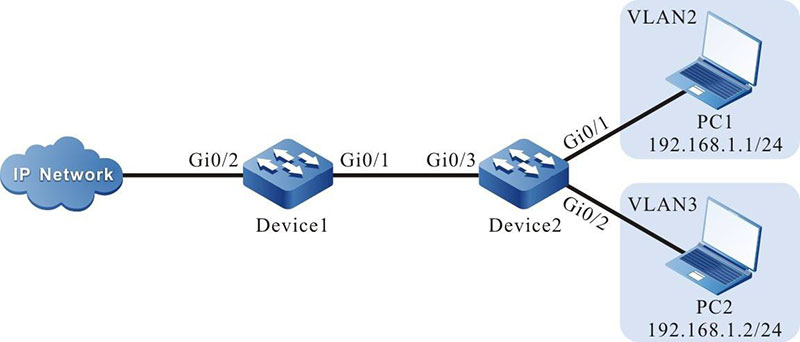Network Requirements
- On device2, PC1 and PC2 are isolated from each other in different VLANs.
- Configure the N:1 VLAN mapping function on Device1 to realize the transmission of PC1 and PC2 service packets in the same VLAN when passing through Device1, so as to save VLAN resources.
Network Topology

Figure 4-4 Configuring N:1 VLAN Mapping
Configuration Steps
Step 1: Configure Device1.
#Create VLAN2-VLAN4 on Device1.
|
Device1#configure terminal
Device1(config)#vlan 2-4
|
#On Device1, configure the link type of port gigabitethernet0/1 to Trunk and allow services of VLAN2 and VLAN100 to pass, and set PVID to 1.
|
Device1(config)#interface gigabitethernet 0/1
Device1(config-if-gigabitethernet0/1)#switchport mode trunk
Device1(config-if-gigabitethernet0/1)#switchport trunk allowed vlan add 2-4
Device1(config-if-gigabitethernet0/1)#switchport trunk pvid vlan 1
|
#Configure the N:1 VLAN mapping function on the port gigabitothernet0 / 1 of Device1 to map VLAN2 and VLAN3 to vlan4.
|
Device1(config-if-gigabitethernet0/1)#vlan dot1q-tunnel mapping n-to-1 enable
Device1(config-if-gigabitethernet0/1)#vlan dot1q-tunnel mapping n-to-1 2-3 4
Device1(config-if-gigabitethernet0/1)#exit
|
#Configure the link type of port gigabitethernet0/2 on Device1 as trunk, which allows vlan2 - vlan4 services to pass through, and the PVID is configured as 1.
Device1(config)#interface gigabitethernet 0/2
Device1(config-if-gigabitethernet0/2)#switchport mode trunk
Device1(config-if-gigabitethernet0/2)#switchport trunk allowed vlan add 2-4
Device1(config-if-gigabitethernet0/2)#switchport trunk pvid vlan 1
Device1(config-if-gigabitethernet0/2)#exit
|
Step 2: Configure Device2.
#Create VLAN2 and VLAN3 on Device2.
|
Device2#configure terminal
Device2(config)#vlan 2-3
|
#On Device2, configure the link type of port gigabitethernet0/1 to Access and allow services of VLAN2 to pass.
|
Device2(config)#interface gigabitethernet 0/1
Device2(config-if-gigabitethernet0/1)#switchport mode access
Device2(config-if-gigabitethernet0/1)#switchport access vlan 2
Device2(config-if-gigabitethernet0/1)#exit
|
#On Device2, configure the link type of port gigabitethernet0/1 to Access and allow services of VLAN3 to pass.
|
Device2(config)#interface gigabitethernet 0/2
Device2(config-if-gigabitethernet0/2)#switchport mode access
Device2(config-if-gigabitethernet0/2)#switchport access vlan 3
Device2(config-if-gigabitethernet0/2)#exit
|
#On Device2, configure the link type of port gigabitethernet0/1 to Trunk and allow services of VLAN2 and VLAN3 to pass, and configure PVID to 1.
|
Device2(config)#interface gigabitethernet 0/3
Device2(config-if-gigabitethernet0/3)#switchport mode trunk
Device2(config-if-gigabitethernet0/3)#switchport trunk allowed vlan add 2-3
Device2(config-if-gigabitethernet0/3)#switchport trunk pvid vlan 1
Device2(config-if-gigabitethernet0/3)#exit
|
Step 3: Check the result.
#On Device1, query the entry information of N:1 VLAN mapping.
Device1#show vlan dot1q-tunnel mapping n-to-1 configuration
--- --------------- -------- ----------------- -----------------------------------
NO. Name Status Customer Member Service VLAN
--- --------------- -------- ----------------- -----------------------------------
1 gi0/1 enable 2-3 4
#On Device2, the services of PC1 and PC2 are isolated from each other, the service packets of PC1 are transmitted in VLAN2, and the service packets of PC2 are transmitted in VLAN3.
#The service packets of PC1 and PC2 accessing IP Network are forwarded through VLAN4 of Device1.
 Switch
Switch Wifi - Access Point
Wifi - Access Point Firewall
Firewall Router
Router Module Quang
Module Quang![Module Quang Cisco]() Module Quang Cisco
Module Quang Cisco![Module quang HPE]() Module quang HPE
Module quang HPE![Module quang Maipu]() Module quang Maipu
Module quang Maipu![Module quang Brocade]() Module quang Brocade
Module quang Brocade![Module quang Fortinet]() Module quang Fortinet
Module quang Fortinet![Module quang Aruba]() Module quang Aruba
Module quang Aruba![Module quang OEM]() Module quang OEM
Module quang OEM![Module quang Juniper]() Module quang Juniper
Module quang Juniper![Module quang Dell]() Module quang Dell
Module quang Dell![Module quang Palo Alto]() Module quang Palo Alto
Module quang Palo Alto![Module quang Huawei]() Module quang Huawei
Module quang Huawei![Module quang Arista]() Module quang Arista
Module quang Arista![Module quang F5]() Module quang F5
Module quang F5![Module quang H3C]() Module quang H3C
Module quang H3C![Module Quang Allied Telesis]() Module Quang Allied Telesis
Module Quang Allied Telesis![Module quang SonicWall]() Module quang SonicWall
Module quang SonicWall![Module quang Mikrotik]() Module quang Mikrotik
Module quang Mikrotik![Module quang Handar]() Module quang Handar
Module quang Handar Máy chủ (Server)
Máy chủ (Server) Thiết bị lưu trữ (SAN, NAS)
Thiết bị lưu trữ (SAN, NAS) Load Balancing
Load Balancing Video Conferencing
Video Conferencing Phụ kiện máy chủ
Phụ kiện máy chủ Thiết Bị IoT
Thiết Bị IoT Phụ Kiện Mạng
Phụ Kiện Mạng




.png)
























